Developed together to save money, the MJ Comanche and XJ Cherokee were designed to provide better off-road capability than any other pickup in its class. Both broke the rules quite successfully; their unibody chassis saved weight and toughened the bodies, and clever design made them superior off-road and, often, on-road. The Cherokee remains legendary; the Comanche has largely been forgotten, though in some ways it was more impressive.

The main difference between the two was that the Cherokee was a true unibody, while the Comanche pickup had a frame for the truck bed. In both cases, the unibody portion was a “first.” The Comanche had two different frames for the bed, one for each bed length/
The Comanche was rear wheel drive based, with an optional “Command-Trac” four wheel drive system that could change modes at any speed. At the time, this was quite advanced and convenient; many four wheel drive vehicles required stopping or slowing.
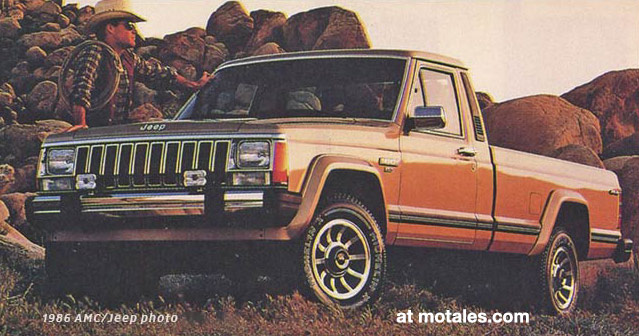
One serious challenge was having a high ground clearance without making the cab too tall (as it is in today’s 4x4 pickups). They did not just succeed, but beat Chevy, Ford, and Dodge; at once, Jeep had lower sills and seats, and greater ground clearance. Buyers could go off-road, without sacrificing on-road handling or bed-loading convenience.
The Comanche even ended up having a higher payload than the Ford Ranger and Chevrolet S-10.
The Comanche used front disc and rear drum brakes, with vacuum-based power assist. Drum brakes were still common in the back, to make the emergency brake cheaper and easier. But that was not the end of the story.
Coming from Europe, Francois Castaing insisted on brake pressure proportioning, which was common there and sorely lacking in the United States. The Comanche’s system was rather clever; it attached to the bottom of the bed, and by seeing how close the bed got to the rear axle, estimated the weight being carried. As weight increased, the system sent more braking power to the rear, which had more stopping power as weight increased.
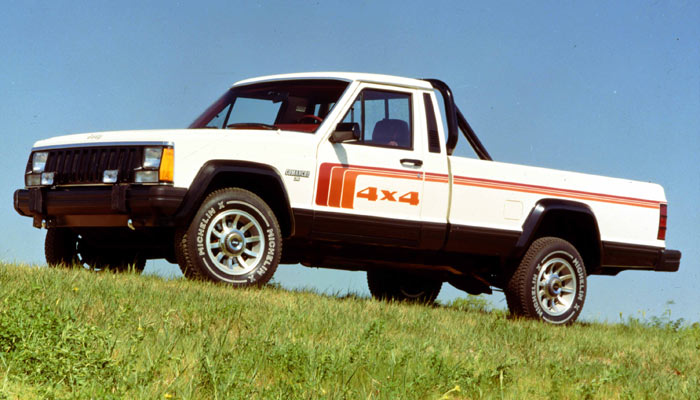
Because of this clever and reliable system, when unloaded, the Comanche didn’t let the rear tires skid around; and when loaded, it stopped faster and better than pretty much any competitive pickup, not to mention many cars.
One secret of the Comanche’s good road manners was its front Link/Coil (multilink) front suspension, which coupled coil springs with upper and lower control arms and a track bar. That setup provides good wheel travel (articulation), and is light and compact, which is why it was adapted later to the Grand Cherokee and Wrangler. The main modification came in 1990, with twin-tube shock absorbers and an optional monotube gas shock setup with a larger (1.77”) bore for off-road use. Steering was a recirculating ball design.
The rear suspension echoed other pickups with leaf springs, to get high payloads (with the metric-ton package, up to 2,205 or 2,240 pounds, comparable to some full-sized pickups). For durability and safety with that payload, Jeep used heavy-duty U-joints and propshafts, Dana 44 rear axles, and heavy duty brakes; the metric ton package had semi-floating hybrid axles, pinions, and differential cases, smaller wheel bearings, and Dana 35C wheel ends on the axle shafts. The payload rose in 1989 with upgrades to the rear suspension.
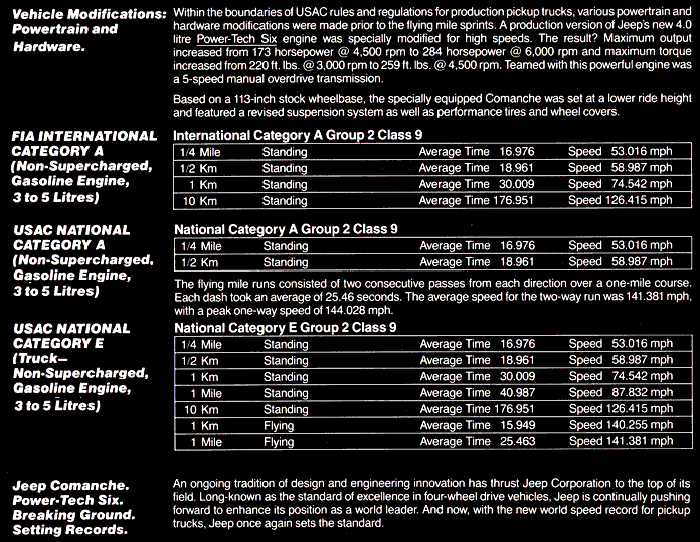
Without the tow package, people could tow 1,400 pounds with 1986 models; by the next model year, they had added 75 pounds to make 1,475. The standard axle was a Dana 35 or Chrysler setup; adding the tow package changed the axle as well. All wheels were fifteen-inch types, regardless of other packages.
Given how small AMC was, they had to buy transmissions. They chose Aisin-Warner (a joint venture between Aisin Seiki and Borg Warner) for manual transmissions, using the AX line for four and five speeds, and also a Peugeot BA-10/5 five-speed from 1987 until mid-1989. They bought three-speed Chrysler automatics in 1986, but starting in 1987, the sole auotmatic was the Aisin-Warner W-4 four-speed. That alone made the Comanche pretty unique for an American pickup truck.
The 1988 Comanche, as one example, weighed in at just under 2,900 pounds, making it heavier than the CJ-based Scrambler, but much lighter than today’s 4,650-pound Gladiator. Ground clearance was 8.4 inches, well above the old J-10 Gladiator pickup (7.5) or the Scrambler (7.6), but not quite as much as the current Gladiator’s 10 inches. On the other hand, it boasted a better breakover and departure angle. It was also much shorter—179.2 inches long vs 218.0 inches long, or for that matter 63.7 inches high vs 75.0 inches high—than the modern Gladiator.
The Comanche was light, at around 3,000 pounds, both for today and for the time; like the Ford and Chevy pickups, it had a base four-cylinder and an optional V6 when launched as a 1986 model. The V6 was not a good choice—made by GM, it was prone to oil and head gasket leaks. The Peugeot diesel was advanced, with decent performance and good economy, but was still not popular. The popular choice was the four-cylinder gasoline engine, fuel-injected and rated at 121 hp and 141 pound-feet of torque—making the most powerful four-cylinder in its class.
The four-cylinder was technically 2.46 liters, or an even 150 cubic inches.
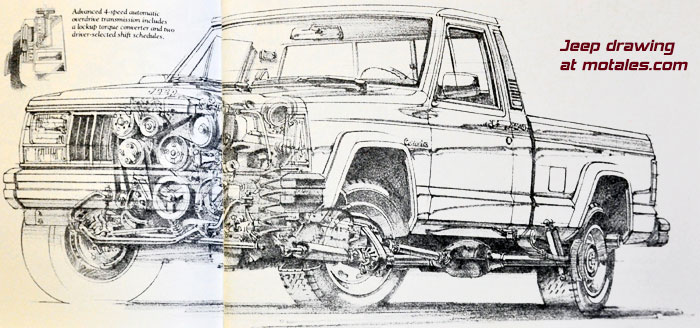
AMC quickly updated the Comanche (and Cherokee) for 1987, its second year, by adding a six-foot bed variant to the original seven-foot bed, and by getting rid of both the GM V6 and the Peugeot diesel. The Peugeot engine was replaced by a similar Renault diesel which didn’t quite make it through the year, due to poor sales, while the GM V6 was replace by a very clever AMC straight-six.
One may ask what was so clever about AMC’s new 4.0 liter six-cylinder engine. It was, after all, basically an update of the antique AMC 4.2 liter six; but that was the genius. They took an obsolete engine, put on a sophisticated multiple-port fuel injection (Renault’s Renix) and updated the heads—just as Dodge later did with its Magnums.

Jeep’s result was a 173-horsepower straight six which was cheaper to make than their (or GM’s or Ford’s) V8, yet had higher horsepower. Indeed, it also beat the Dodge 318 in horsepower—and it still had another 17 hp that would be added, in steps, through 1991. Looking at 1987 alone, in order, horsepower ratings were:
| Jeep 4.0 | 173 |
| Dodge 5.2 | 170 |
| GM 4.3 | 160 |
| Ford 4.0 | 155 |
| Nissan 3.0 | 153 |
| Ford 4.9 | 145 |
| AMC 5.9 | 144 |
The AMC 5.9 (360) V8 was rated at just 144 horsepower, albeit wtih 280 pound-feet of torque. At least into 1988, Jeep also still made the old version of its straight six, the 4.2, which produced up to 210 pound-feet of torque but less than 120 hp.
The Comanche I-6 ran 0-60 faster than many cars, but still had enough torque to tow a respectable 5,000 pounds—and they would only gain in power.
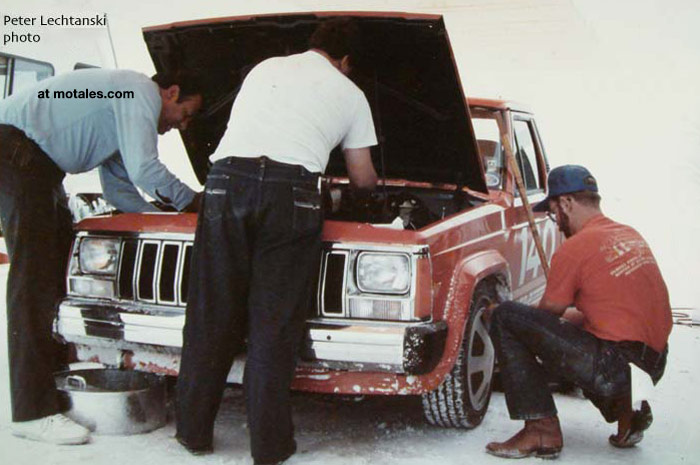
Jeep set its racers to work setting records in late 1985, using modified versions of their four-liter straight-six engines. They set four international records at the Bonneville salt flats; one was running an average speed of 141.381 miles per hour in a two-way dash over a mile-long course, hitting a peak speed of 144.028 mph. See the Land Speed Record Jeep Comanche page at allpar.
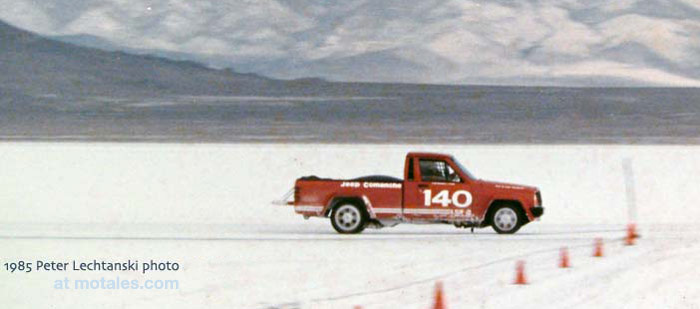
The base engine, a four-cylinder (150 cid or 2.46 liters) based on the old AMC 4.2 straight six, started out at 117 hp. In 1988 it went up to 121 hp, already the most powerful four-cylinder in its class. 1991 brought a torque boost, to 141 lb-ft, and 1992 brought the 2.5 to its highest rating: 130 hp and 149 lb-ft.
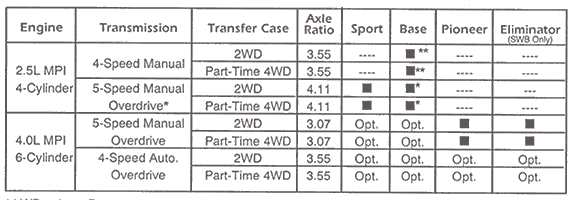
Similarly, the six-cylinder went to 177 hp in 1989 and 190 hp in 1991; that was well above the Chrysler 3.8 liter V6 and even the 5.2 liter V8 (though it couldn’t match V8s for torque). The power boost came even as compression fell from 9.2:1 to 8.8:1.
| Year | 1987 | 1988 | 1990 | 1992 |
|---|---|---|---|---|
| 2.5 hp | 121 @ 5000 | 121 @ 5250 | 130 @ 5250 | |
| 2.5 torque | 121 @ 5250 | 141 @ 3250 | 149 @ 3250 | |
| 4.0 hp | 173 | 177 @ 4500 | 177 @ 4500 | 190 @ 4750 |
| 4.0 torque | 224 @ 2500 | 224 @ 2500 | 225 @ 4000 |
Jeep successfully campaigned Comanches in offroad (SCORE) and paved road (SCCA) competition, using engines built by Lee Hurley.
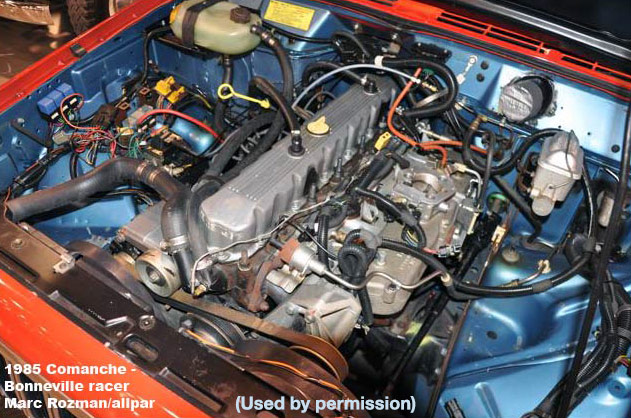
For those seeking lower speeds and higher mileage, in 1988, the best combination was the four-speed manual transmission and four-cylinder engine, turning in 22 mpg city, 25 highway. Adding four wheel drive knocked 2 mpg off each figure. Moving to the five-speed manual was more of a speed move: it dropped gas mileage by 1 mpg for rear drive owners, while leaving it the same for 4x4s. The automatic transmission dropped city mileage to 18 mpg and highway to 24 mpg with rear drive, 23 mpg for 4x4. These numbers were similar to the Cherokee’s.
Straight-six buyers took a hit; they started with 18 city, 24 highway with rear drive and the five-speed manual, dropping 1 mpg for 4x4. The automatic was 16 city, 21 highway regardless of rear drive or 4x4. Most likely that wouldn’t have been the case without the clever 4x4 system that didn’t reuqire extra height.
The interior was designed simply, and meant for easy operation, not unlike Chevy, Ford, Dodge, and Toyota pickups—plastic, squarish, and functional. Large, blocky controls were meant to be operated with gloves on. Head and leg room were generous, but interior storage was minimal by today's norms; and the seats were quite comfortable, providing full visibility all around.
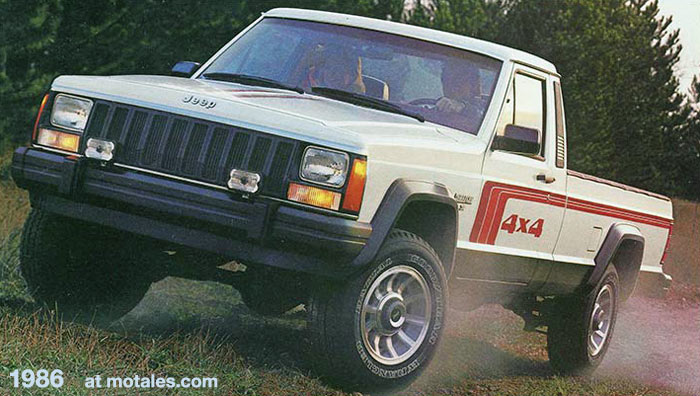
The interior was relatively quiet in road noise, loud for wind noise, even for the time. It was somewhat noisy compared with a Dakota, silent compared with a Toyota T-100. A bench seat was standard except on Eliminators (launched in 1988), which had the otherwise optional bucket seats with head rests.
The track was 57 inches, with a 71.7 inch width and 63.7 inch height, regardless of bed length and driven wheels. The weight was a surprisingly light 3,000 pounds or so, depending on how it was set up, with rear wheel drive—quite svelte for a pickup of this capacity.
| RWD Short | RWD Long | 4x4 Short | 4x4 Long | |
|---|---|---|---|---|
| 2.5 engine | 2895 | 2986 | 3084 | 3182 |
| 4.0 engine | 3042 | 3127 | 3231 | 3304 |
The interior was mildly generous in size for a compact pickup, with 38.6 cubic feet in the short bed and 46.4 cubic feet in the long bed version (and just one row of seats, with one door to get in and out).
Chrysler bought AMC in 1987, and engineers started replacing the hodgepodge of Renault, GM, and Ford parts with Mopar equivalents. For 1991-92, the Renix ignition system and computers were replaced by more-reliable Chrysler systems. The DRBII and Jeep diagnostic ports were protected by yellow rubber covers on the passenger side of the engine bay, one way to tell these apart.
| 1992 Comanche | 1992 Dakota | |
|---|---|---|
| Head room | 39.4 | 39.5 |
| Leg room | 43.0 | 41.8 |
| Hip room | 55.3 | 56.0 |
| EPA cargo volume, c.f. |
38.6 RWD 46.4 4x4 |
n/a |
| Fuel (gal.) | 18.0 Short 23.5 Long |
n/a |
| Four cyl. | 130 hp | 117 hp |
| Six cyl. | 190 hp I6 | 180 hp V6 |
| Eight cyl. | none | 230 hp V8 |
| Max Tow | 5,000 | 6,900 |
| Max Payload | 2,205 | 2,800 |
| Boxes | 6, 7 ft | 6.5, 8 ft |
| Weight | 2,898-3,431 lb |
A new idea for 1988 was the Jeep Comanche Eliminator, which started with the six cylinder engine and five speed manual transmission, and added a body-color grille, air dam, and fender flairs, silver-painted bumpers, and taped stripes. It started with rear wheel drive, but 4x4 was added with the 1990 models. The Comanche Eliminator was meant to bring attention to the six-cylinder engine, already up by 4 hp to 177 hp, 224 pound-feet; it was sold in black, red, or metallic gray. Other models in 1988 were the Sportruck (base model for short bed), an unnamed base model with the long bed, the Pioneer on both beds and with optional four wheel drive, and the top Chief for four wheel drive short beds and Laredo for long beds. Overall, the model setup, varying as it did by bed length, may have confused customers a bit.
Since the Comanche was made on the same line as the Cherokee and XJ-series Wagoneer, but with a lower profit margin, they ironically made more money as they made fewer Comanches. Cherokee demand kept rising, but the Comanche didn’t fare as well, going after more brand-loyal buyers with a unibody cabin and lower bed. It didn’t look as capable as competitors, though it was actually more capable. Finally, given that the Dodge Dakota was one of the Comanche’s competitors, Chrysler shut down Comanche production.
| L | Sample mpg | 1989 | 1992 |
|---|---|---|---|
| 2.5 | Manual 4x2 | 22 / 25 | 21 / 23 |
| 2.5 | Auto 4x4 | 18 / 23 | n/a |
| 4.0 | Manual 4x4 | 17 / 22 | 17 / 21 |
| 4.0 | Auto 4xw | 16 / 21 | 15 / 19 |
Even after the Comanche shut down, Bob Salemi set an IHRA record with a 4-liter Comanche in September 2009, in HT/SA, with a 12.95 quarter mile at 100 mph (New England Dragway). The Dodge Dakota trucks that won the Mickey Thompson Stadium Truck series by a wide margin were, according to engineer Bob Sheaves, Comanches with Dakota sheet metal—using modified 4.0 Jeep engines instead of the Chrysler V6.
Transfer cases were from Chrysler and GM’s New Process Gear, providing a 1:1 high gear and 2.61:1 low gear. The 242 had a variable torque split while the 231 was 50/50.
The A-W 30-40LE four speed automatic had a first gear of 2.80 and a fourth gear overdrive of 0.71.
The four-speed manual, only used with the four-cylinder, had a 3.93:1 first gear and 1:1 top gear. The five-speed A-S manual, used only on the four-cylinder, had the same gear ratios but added a 0.85:1 overdrive, which should have helped with gas mileage, but didn't. The Peugeot five-speed, used only on the six-cylinder, started at 4.03:1 and ended with a 0.72:1 fifth gear.

The Comanche held 18 gallons of fuel with the short bed and 23.5 gallons with the long bed, regardless of driven wheels. Front and rear shocks in 1990 had one-and-three-sixteenths bore, with twin tubes, on the standard suspension; the heavy duty suspension was similar but with a 1 3/8 bore; and the off-road suspension used high-pressure gas monotubes with a 1.77” bore. The leaf springs were mounted below the axle. The power disc front brakes had an 11.02 inch diameter, while the power rear drums had a 9-inch diameter. Wheels were still 15-inch only, with the base wheels being steel and 15x6 (four-cylinder engine); the six-cylinder and all optional wheels were 15x7 (seven inches wide, 15 inch diameter), with aluminum and styled steel both available as options. Tires ranged from 195 to 225 widths with sidewall ratios of 75 regardless.
|
1988 Comanche |
2020 Gladiator |
|---|---|---|
Width |
71.7 |
73.8 |
Height* |
63.7 |
75.0 |
Box length |
72 and 84 |
60 |
Overall length |
179 / 195 |
218 |
Box width |
55.3 |
44.8 to 56.8 |
Approach angle* |
38° or 40° |
40.8° |
Breakover* |
21° |
18.4° |
Departure angle |
30° / 24.8° ** |
25° |
Ground clr.* |
8.4 |
10 |
Curb weight* |
2,898 |
4,650 |
Front headroom |
39.4 |
40.8 |
Front leg room |
43.0 |
41.2 |
Rows of seats |
1 |
2 |
Max tow |
5,000 lb*** |
7,650 lb |
Max payload |
1,475 |
1,600 |
Man. trans. |
4 or 5 speed |
6 speed |
Auto. trans. |
4-speed |
8-speed |
4x4 low gear |
2.61 or 2.72 |
2.72 |
4x4 system |
Part-time |
Part-time |
* Base model, hardtop if applicable
** Short bed / long bed
*** 2,000 lb base hitch, 4,000 lb Class B hitch, 5,000 lb with I-6, automatic, Class B hitch.
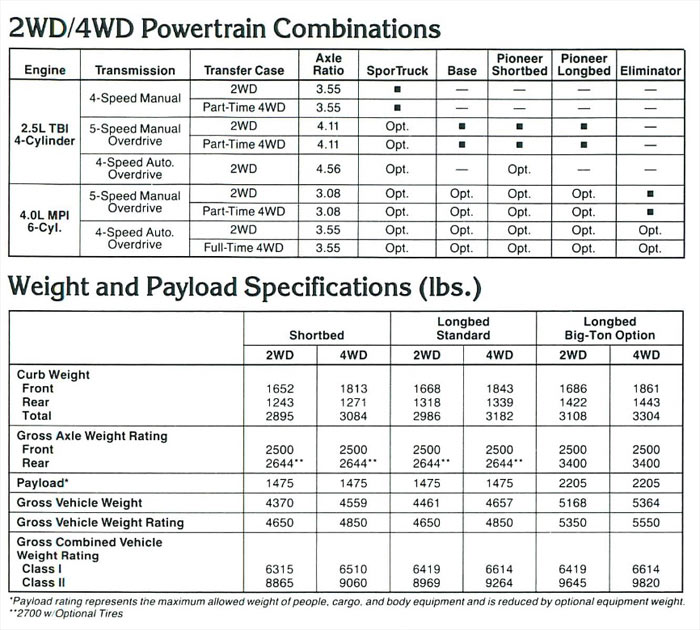
Copyright © 2021-2025 Zatz LLC • Chrysler / Mopar car stories and history.
YouTube • Editorial Guidelines • Videos